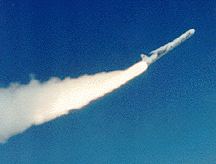Launch Problem Thwarts New Missions

The Pegasus XL booster, seen above being prepared to carry the two spacecraft, was built by Orbital Sciences Corporation.
|
The November 4 launch of two new high energy astrophysics missions, SAC-B
and HETE, ended in disappointment when the third stage of the launch vehicle
failed to separate. The two spacecraft and the rocket stage remained locked
in a position which prevented HETE's solar panels from opening, and kept
SAC-B's solar panels from pointing properly at the Sun. Unable to generate
power to communicate with the Earth, run their instruments and recharge their
batteries, the spacecraft will not be able to fulfill their scientific
missions.
The HETE spacecraft was attached to the third stage of the launch vehicle
at the ring shown in the right side of the picture. A cylindrical adaptor
was mounted over HETE, and the conical adaptor shown in the lower foreground
was placed over the cylinder. The SAC-B spacecraft mounted to the ring on
the narrow end of the conical adaptor.

The Pegasus with its payload was attached to the belly of a Lockheed 1011
aircraft, which took off from NASA's Wallops Flight Facility in Virginia
and carried the Pegasus rocket to an altitude of about 40,000 feet before
releasing it. |
SAC-B (Satellite de Aplicaciones Cientificas-B) was a cooperative
project between NASA and the space agency of Argentina. The 400 pound satellite
carried three astronomical instruments, with five detectors in all. The
Goddard X-Ray Experiment was intended to measure soft X-rays emitted from
gamma-ray bursts and solar flares. The Cosmic Unresolved X-Ray Background
Instrument was to study the background radiation emanating from our galaxy
and from the Universe as a whole. An Italian instrument designed to detect
energetic neutral atoms was also on board.

After release from the L1011, the rocket motors were ignited and the Pegasus proceeded to the planned orbit, which took about 10 minutes. Since the separation of the spacecraft from the launch vehicle didn't occur, the rocket stage and two spacecraft continue to orbit as one unit.
NASA and Orbital Sciences have each convened panels to investigate the problem.
|
HETE (High Energy Transient Experiment) was a collaboration between NASA and
the Massachusetts Institute of Technology. It carried a gamma-ray burst
detector along with X-ray and ultraviolet cameras. These instruments were
intended to work together so that scientists could pinpoint the location
of the bursts with greater precision.
|
